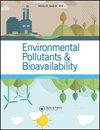有机肥堆肥中磷的生物有效性评估
Q3 Chemical Engineering
引用次数: 32
摘要
摘要城市污水处理厂产生的污泥是宏量营养素、微量营养素和有机物的重要来源。因此,污水污泥堆肥,以及燃烧和共燃烧,是波兰新的管理重点。本研究对6种不同来源和组成的堆肥进行了磷丰度评价,因为磷是所有生物必需的营养物质。对堆肥初期和成熟阶段的样品进行了分析。磷的生物利用度是根据分离馏分中磷的含量用顺序萃取法估算的。首先,总养分含量及其在分离馏分中的含量的定量变化取决于混合物的组成。不考虑堆肥类型,34.5-75.0%的磷是难效态组合(Fr. III),而有效态磷(Fr. I)仅占6.6-21.6%。由于将不同的有机废物放在一起堆肥,在分离馏分中观察到这种养分的总含量和数量都有所增加。这种现象在污水污泥含量较低(30-40%)的堆肥中尤其明显,其特点是有机物分解迅速,这表明磷的生物可利用量较高。在此条件下,磷含量在3.68 ~ 7.4 g kg−1之间。与成熟堆肥C5和C6(占污泥成分的65%和75%)获得的活性磷池(2.45-3.0 g kg - 1)相比,上述数值相当可观。按170公斤总氮/公顷/年计算的堆肥剂量,可能引入土壤的生物有效磷含量范围为:污水污泥比例最低的堆肥为69.8至80.2公斤,污水污泥比例最高的堆肥为11.2至20.7公斤。本文章由计算机程序翻译,如有差异,请以英文原文为准。
Estimation of phosphorus bioavailability from composted organic wastes
Abstract Sewage sludge derived from municipal sewage treatment plants is an important source of macronutrients, micronutrients and organic matter. For this reason composting of sewage sludge, along with combustion and co-combustion, is a new management priority in Poland. In this study six composts of different origin and composition were evaluated in terms of their abundance in phosphorus, because it is an essential nutrient for all living organisms. Analyses were conducted on the samples at the initial and at the maturation phase of composting. The bioavailability of phosphorus was estimated on the basis of amounts of the nutrient in isolated fractions using the sequential extraction method. First of all quantitative changes of the total nutrient content and its amounts in separated fractions were dependent on the mixture composition. Irrespective of compost type, 34.5–75.0% of the total amounts of phosphorus were found in hardly available combinations (Fr. III), while available phosphorus forms (Fr. I) accounted for only 6.6–21.6%. As a result of composting together different organic wastes an increase was observed both in the total content and the amounts of this nutrient in separated fractions. This phenomenon was observed particularly in composts with smaller levels of sewage sludge (30–40%), characterised by rapid organic matter decomposition, which was indicated by higher bioavailable amounts of phosphorus. Under such conditions the content of P ranged between 3.68 and 7.4 g kg−1. In comparison to the labile pool of P obtained for matured composts C5 and C6 (65 and 75% of sewage sludge in their composition) amounting to 2.45–3.0 g kg−1 the above values were considerable. Bioavailable phosphorus contents potentially introduced to soil with composts doses calculated at 170 kg total N/ha/yr ranged from 69.8 to 80.2 kg for compost with the lowest share of sewage sludge and from 11.2 to 20.7 kg for compost with the highest share of sewage sludge.
求助全文
通过发布文献求助,成功后即可免费获取论文全文。
去求助
来源期刊
CiteScore
1.62
自引率
0.00%
发文量
0
审稿时长
1 months
期刊介绍:
Chemical Speciation & Bioavailability ( CS&B) is a scholarly, peer-reviewed forum for insights on the chemical aspects of occurrence, distribution, transport, transformation, transfer, fate, and effects of substances in the environment and biota, and their impacts on the uptake of the substances by living organisms. Substances of interests include both beneficial and toxic ones, especially nutrients, heavy metals, persistent organic pollutants, and emerging contaminants, such as engineered nanomaterials, as well as pharmaceuticals and personal-care products as pollutants. It is the aim of this Journal to develop an international community of experienced colleagues to promote the research, discussion, review, and spread of information on chemical speciation and bioavailability, which is a topic of interest to researchers in many disciplines, including environmental, chemical, biological, food, medical, toxicology, and health sciences.
Key themes in the scope of the Journal include, but are not limited to, the following “6Ms”:
Methods for speciation analysis and the evaluation of bioavailability, especially the development, validation, and application of novel methods and techniques.
Media that sustain the processes of release, distribution, transformation, and transfer of chemical speciation; of particular interest are emerging contaminants, such as engineered nanomaterials, pharmaceuticals, and personal-care products.
Mobility of substance species in environment and biota, either spatially or temporally.
Matters that influence the chemical speciation and bioavailability, mainly environmentally relevant conditions.
Mechanisms that govern the transport, transformation, transfer, and fate of chemical speciation in the environment, and the biouptake of substances.
Models for the simulation of chemical speciation and bioavailability, and for the prediction of toxicity.
Chemical Speciation & Bioavailability is a fully open access journal. This means all submitted articles will, if accepted, be available for anyone to read, anywhere, at any time. immediately on publication. There are no charges for submission to this journal.

 求助内容:
求助内容: 应助结果提醒方式:
应助结果提醒方式:


